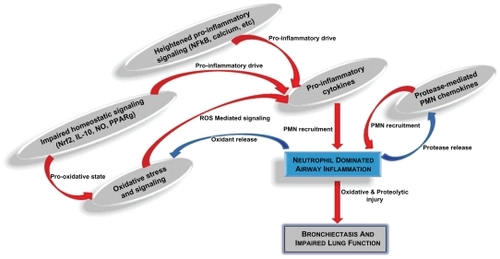Figures & data
Figure 1 Complex interactions contributing to CF airway inflammation. Several proinflammatory mechanisms have been identified in research of cystic fibrosis (CF) airway disease. Heightened proinflammatory signaling pathways, impaired redox-regulation and anti-inflammatory signaling pathways, and perpetual proteolytic and oxidative stress are some of the most well-described mechanisms driving the neutrophil-dominated host response. This neutrophilic inflammation, along with ineffective airway clearance and chronic airway infection, lead to progressive bronchiectasis and impaired lung function.
Abbreviations: PMN, polymorphonuclear cell, ie, neutrophil; ROS, reactive oxygen species; NO, nitric oxide.

Table 1 Current and potential outcome measures for use in clinical trials of new anti-inflammatory therapies in CF